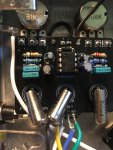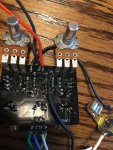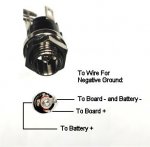Coda
Well-known member
Just completed the Tone Vendor MKII build. I plugged it all in, and got nothing. Bypass tone was fine, LED was on, but no fuzz...just a very high-pitched whistle...like something a dog could hear. After about 2 hours of checking and re-checking everything, I finally got sound. However, it sounds like the fuzz is on 5...even though the fuzz control is maxed.
It seems that after poking around (I literally was just pressing my finger against the board...especially around where the fuzz control/output ground/9v hooks up), it just came on. Is this a bad connection? What would make the fuzz control useless, while delivering a half-assed fuzz? Should I just chuck this build in the ocean and start over?
It seems that after poking around (I literally was just pressing my finger against the board...especially around where the fuzz control/output ground/9v hooks up), it just came on. Is this a bad connection? What would make the fuzz control useless, while delivering a half-assed fuzz? Should I just chuck this build in the ocean and start over?
Last edited:





